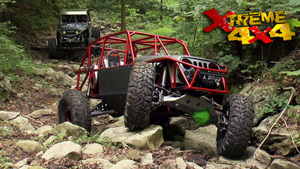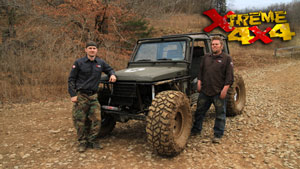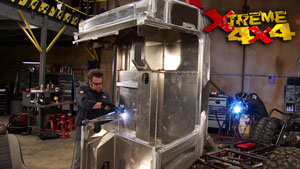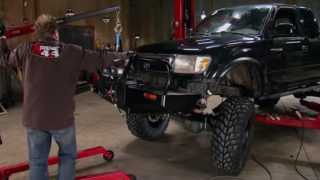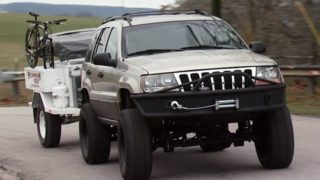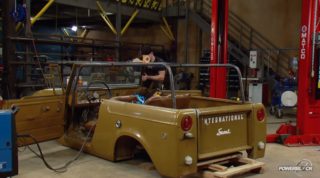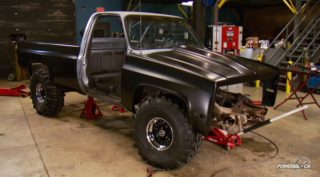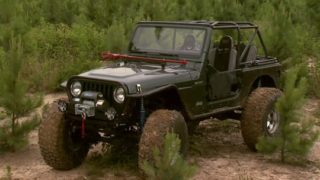More '85 Suzuki Samurai Episodes
Xtreme 4x4 Builds
Want more content like this?
Join the PowerNation Email NewsletterParts Used In This Episode
Grease Car
Veggie Conversion Kit.
PRP Seats
Suspension Seats and 1 Pre-Teen Suspension Seat.
Rocky Road Outfitters
Jetta Diesel Engine Swap Kit - includes transmission adapter plate, motor mounts, wiring harness, and exhaust header.
Sky-Manufacturing
High Steer Kit - includes IFS Steering Box, billet high steer arms, tie rod and drag link with FJ80 ends.
Spidertrax
1 1/2" Wheel Spacers.
Episode Transcript
Does every fill up, empty your wallet today. An Xtreme 4x4 episode, our federal government would rather you not see, Ian and Jessi build a green samurai that runs on fuel. Uncle Sam can't tax. It's a non polluting money saving alternative to gas and diesel right now on Xtreme 4x4.
What's up guys? Welcome to extreme
by,
for,
as you can see, our project
is back in the shop to get finished up and head out on the trail. But once used to be a cute little four
W drive commuter is now a hardcore trail truck just begging for its time out on the trail.
Now, it all started when we removed the stock Suzuki axles and replaced them with two Toyota units that we got from a junk yard. Now, we hung those on a custom double triangulated four length, both front and rear and suspended them with Q A one coil springs and Edelbrock extreme travel shocks plus a new
of 65
years in the transfer case. A
brand new set of well on the
locks made our wheels look pretty insane. And finally 35 inch tall pit bull tires which were unfortunately rubbing on the frame and we tested the flex on our suspension.
So to solve this, we're going to be using some real spacers from spider tracks.
A wheel spacer does exactly what its name implies. It spaces the wheel further away from the original mountain plan,
the spider track spacers are vehicle specific
and our 1.5 inch thick units are 6061 T six aluminum with ana
for corrosion resistance.
Now, although we left the internals of our Toyota axles completely stocked. We knew that a high steer kit was gonna be money well spent.
Now, our complete kit comes from Sky's off road manufacturing and for just under 500 bucks, we get everything we need including a good used ifs steering box. Now, not only will the high steer kit relocate our steering arm up out of harm's way. The aftermarket pieces are a lot stronger than the stock Toyota stuff.
The kit includes new billet, high steer arms,
upgraded tie rod and drag link with Beefy FJ 80 Ns
and new jam knives.
Since our steering box is obviously not going on to a Toyota frame, we'll have to build a custom mount onto the samurai.
Now, this IFS box is a power steering box which will help us turn in the tires. But to make it even easier, we're going to go ahead and drill and tap this box to divert the power steering fluid out of the steering gear down into hydraulic ram that will mount on the axle itself that will help push and pull the tie rod and make steering even easier.
I have a question for Jessi.
Do you know why they spell Toyod? A
as Toyota
Toyta? I don't know.
Do you know
if you do, go ahead and send us an email and we'll send you an official Xtreme 4x4 coffee mug.
It'll even be used
and
autograph. It's recyclable
with the box off the truck. It can be completely disassembled to a bare housing.
Then two holes need to be drilled and tapped. Top hole goes into the existing fluid passageway.
The second hole goes through the D on the Toyota stamp on the side of the gear
tap, the holes using an eight inch NPT thread tap.
Then with the box and the parts cleaner, we'll give it a good scrubbing,
then we can completely reassemble the gearbox.
If this is something you've never done before, grab a service manual from your local parts store and follow the instructions step by step.
Now, all that's left to do is measure the length or stroke of the hydraulic cylinder we need for the ra M assist.
And we do that by turning the wheels all the way to the right and then again, all the way to the left, measuring the distance that the tie rod travels. In our case, it's going to be about six inches long.
Now, to say that the original seats in the Suzuki had seen better days is a complete understate.
And typically when you see these trucks, they're hauling their entire families through the trails. So we definitely needed more than just two seats
in the front. We're gonna be using pr p suspension seats with adjustable headrest
and in the rear, we're gonna be using what they call a preteen seat. It's made for kids under 13 years of age and is basically a smaller scale down version of the full size.
Now, we could have found you seat at a rocking yard are
low cost plastic buckets.
But since we save money on almost every portion of this bill
for a little bit, the seat are not only way more comfortable but much safer than drug
finds.
Money. Well,
now we could have spent a little bit more money and upgraded our Suzuki four cylinder. But instead we've got another plan.
Now there's nothing really wrong with this little four cylinder that came out of our Suzuki. But the engine that we're gonna replace it with is gonna have a lot more power and it will be environmentally friendly.
Yes, like Al Gore or Greenpeace or a whale.
A whale is environmentally friendly. Yeah, they're always important
later on the secret behind our Eco friendly four by four plus a trail test that proves our Sammy kicks gas. Stay tuned.
Welcome back to Xtreme 4x4 with the gas engine out of the
Suki Samurai. We're about to perform one of the coolest engine swaps ever to this
VW Turbo diesel.
It's out of a 99 Jetta we picked up for 1000 bucks.
Anybody that knows these motors know they can typically run 400 1000 miles without an overhaul. And we just under 60,000 miles on ours, we think we got a steal of a deal and by putting diesel in our Sammy, we're not only going to get the fuel injection that works great off road, but we're going to get more power and awesome low end torque all without any spark plugs.
Now, a diesel engine and a gasoline engine are very similar. They're both internal combustion engines that burn a fuel to create power by forcing the piston down inside the cylinder. But how that fuel is ignited is the difference. A gasoline engine uses a spark plug to ignite the compressed air and fuel mixture
and that's what causes the piston to move.
Now, the diesel engine obviously works different when the air is compressed, there's no fuel in it
and they actually fire the injector
only into that compressed air mixture. And that is what ignites the fuel, the fuel is ignited by the compression of that air heat as well as the pressure.
Now, the benefit to a diesel engine is basically its compression ratio. A
high performance gasoline engine may have a 12 to 1 compression ratio. A
diesel engine will have 14 to 1 up to 25 to 1
that allows more oxygen to interact with the fuel because it's basically crammed closer together. This makes it more efficient, more
means we get more power, more torque and less emissions because more of the fuel is being burned and not sent out the tailpipe
swapping a diesel engine into a
Suzuki Samurai is not a new idea.
And the guys from Rocky Road outfitters have made a complete swap kit just for this application
and includes everything you need to replace the gas engine with a Jetta diesel, everything from your transmission adapter plate to motor mounts to your wiring harness and even your exhaust ha
It starts with changing over the water temperature
and oil pressure sensors from the Samurai engine to the VW.
This is so stop
dash still functions.
Motor mounts can be bolted to the engine.
We will keep the old alternator and bolted to the diesel with the supplied mount.
The adapter plate is then bolted to the back of the engine and the new flywheel reinstalled on the crank.
The transmission bell housing bolt holes need to be enlarged according to the instructions,
then the engine can be installed into the truck.
Now, we just gotta hook up the lines for our diesel fuel to run into the three gallon cell that we got from summit. It's so small, we can fit it right under the hood. Now, I know what you guys were thinking. Three gallons. That's not a lot of fuel even for an engine that gets almost 45 miles to gallon.
But in a minute we're gonna be slipping in an auxiliary fuel cell in the back of this truck that'll turn this Suzuki into a vegetarian.
Mm. I like vegetables.
Welcome back to Xtreme 4x4 in our little green Suzuki samurai build up and by green, I'm referring to more than just the color of the paint on that truck.
Now, let's face it. The environment is a huge issue to a lot of people nowadays and that little trail truck is about as environmentally friendly as an
off road vehicle can get.
The truck itself is reused from a wore out old commuter vehicle.
The wheels and the axles are recycled out of a Toyota that we pulled from a junkyard.
And thanks to this kit that we got from grease car, this vehicle is soon going to be running on an alternative fuel source.
A diesel engine is often referred to as an oil burner and that's because diesel fuel is just that oil, not gas.
The increased compression ratio allows almost any oil product to burn in the combustion chamber once the engine has reached operating temperatures and that includes vegetable oil.
Thank
you.
Now, grease car makes a Veggie conversion kit for almost any diesel vehicle out there.
And ours is a complete kit for a 1999 VW Jetta, which is the same car that our donor motor came out of. Now, it's a pretty simple system. When you think about how it works, it's basically a dual fuel with two separate tanks. There's solenoids mounted up underneath the hood, one will be switched on to deliver diesel fuel up to the back of the injection pump and
the other one is switched on to deliver vegetable oil up to the back of the injection pump when the diesel is turned off.
Now, the key here, as Jessi said, is keeping that fuel at engine operating temperature and grease car does that in a pretty ingenious way. It starts with a heating element that's down inside the vegetable oil tank. Now, this accepts engine coolant from the motor and the fuel is picked up really close to it so it stays nice and warm.
I'm sure you're thinking once that fuel comes out of this tank, it's probably gonna begin to cool down.
But when you install the system, the fuel line is actually inserted inside of a heater hose. And that way it will stay at the right temperature all the way up until it gets underneath the hood under the hood. It will obviously need to be filtered. So they have a filter that's wrapped with a coil that is also heated by the engine and then it's off into the injection pump once it goes through the solenoid.
Now our kit, we opted for the control module from grease car. Now, the nice thing about this is it can operate in a couple of different modes. It can have a manual mode where you actually have to physically select either diesel or vegetable oil or an automatic mode. Now, the automatic mode will not only measure the engine coolant temperature, but it will also measure the temperature of the vegetable oil itself. When this reaches the optimum temperature for it to
burn inside the motor, it'll automatically switch from diesel over to the vegetable oil making this kit almost brain dead to operate.
Now, one thing you do have to remember when you're installing a vegetable oil conversion is you don't want to shut the diesel engine off while it's still running on the veggie. If you do that, it can actually gel inside the lines as well as inside the injection pump. Now, the nice thing about the grease car kit is if you turn the key off while you're still running on vegetable oil, the solid
as well as the computer will automatically flush the system and get rid of all that vegetable oil. So it won't gel inside the lines and the truck will still start.
Now, because of that gelling and the fact that this is a trail truck, we're gonna go ahead and use some of this Gold Eagle diesel power anti gel and fuel treatment in both the veggie tank as well as the diesel tank. This will keep the fuel from becoming gelled when it gets cooler. And that way, every time we jump in our samurai. It'll start right up.
The installation will start under the hood where we'll mount the Veggie filter and the solenoids
heater hoses are hooked up to both the engine and the tank
one with the fuel line fed through it.
Then the grease car control module is mounted in the cab
and the digital display is mounted within the reach of the driver
since this project is obviously not a Jetta Greece car made it a custom fuel cell specifically for this application.
Now, you guys are probably wondering where do you get this oil that you guys are talking about?
Because it's not like you can just pull to the gas station and get vegetable oil directly from the pump. But what you can do is go to one of your local restaurants that has fried food and they'll probably give it to you. And I bet if you're nice enough, they might actually pay you to take it away.
We're back on extreme and our 87 Suzuki Samurai has undergone a huge transformation from a worn out daily commuter,
a
hard core trail truck with all the typical Goodies
Toyota Junkyard axles, long travel suspension, hydraulic assist for
rock and rear suspension seats. Full ex ok. But most importantly, we gave it an oil change.
Goodbye. Fossil fuel. Hello,
that
oil.
Yep. The green samurai makes a huge statement as it crawls through the woods.
It's our first hybrid, so to speak. Thanks. To a used 1.6 L turbo diesel from a VW Jetta combined with a grease car waste vegetable oil conversion.
He
you can cook with.
Mm.
Arzu rolls on fuel that costs nothing.
Well, almost
ours is a two tank system that starts on diesel fuel and as the engine gets to operating temperature,
the veggie oil is heated to a lower viscosity.
Hit the veggie button on the grease car computer and off you go.
This thing works awesome
with diesel at over three and a quarter a gallon. The immediate impact is on your wallet with long term effects at the tail.
50% reduction in carbon dioxide emissions, 26% less carbon monoxide, nearly zero nitrous oxide emissions and 50% less sulfur dioxide. The stuff that causes smog and acid rain
so we can give back a little to the environment while saving some cash.
Now, what about performance? The flex and ride of the Zook is awesome.
Thanks to the Q A one coil springs and the inertia active valving system in the Edelbrock shops, the trail gear 6.5 to 1 gear set in the transfer case, helps this truck truly crawl.
And the low end torque put out by our diesel gives this samurai some serious low end grunts.
The 101 inch wheel base means we can get it in and out of some pretty tight spots.
It.
Ok.
That's why
in the compact size and weight.
I'll just
hang
out,
we can get it out of a jam with a little help from our friends.
So our green samurai answers a couple of inconvenient truths about four wheeling. Number one, you don't need deep pockets to build a capable trail truck.
Ours, lock stock and barrel came in at just over six grand
two. You can tread lightly,
not only by using recycled parts
but with a veggie oil conversion that produces very little emission.
And with you that cost $0 per gallon. All we can say is
I love
Grace is the Lord.
Show Full Transcript
What's up guys? Welcome to extreme
by,
for,
as you can see, our project
is back in the shop to get finished up and head out on the trail. But once used to be a cute little four
W drive commuter is now a hardcore trail truck just begging for its time out on the trail.
Now, it all started when we removed the stock Suzuki axles and replaced them with two Toyota units that we got from a junk yard. Now, we hung those on a custom double triangulated four length, both front and rear and suspended them with Q A one coil springs and Edelbrock extreme travel shocks plus a new
of 65
years in the transfer case. A
brand new set of well on the
locks made our wheels look pretty insane. And finally 35 inch tall pit bull tires which were unfortunately rubbing on the frame and we tested the flex on our suspension.
So to solve this, we're going to be using some real spacers from spider tracks.
A wheel spacer does exactly what its name implies. It spaces the wheel further away from the original mountain plan,
the spider track spacers are vehicle specific
and our 1.5 inch thick units are 6061 T six aluminum with ana
for corrosion resistance.
Now, although we left the internals of our Toyota axles completely stocked. We knew that a high steer kit was gonna be money well spent.
Now, our complete kit comes from Sky's off road manufacturing and for just under 500 bucks, we get everything we need including a good used ifs steering box. Now, not only will the high steer kit relocate our steering arm up out of harm's way. The aftermarket pieces are a lot stronger than the stock Toyota stuff.
The kit includes new billet, high steer arms,
upgraded tie rod and drag link with Beefy FJ 80 Ns
and new jam knives.
Since our steering box is obviously not going on to a Toyota frame, we'll have to build a custom mount onto the samurai.
Now, this IFS box is a power steering box which will help us turn in the tires. But to make it even easier, we're going to go ahead and drill and tap this box to divert the power steering fluid out of the steering gear down into hydraulic ram that will mount on the axle itself that will help push and pull the tie rod and make steering even easier.
I have a question for Jessi.
Do you know why they spell Toyod? A
as Toyota
Toyta? I don't know.
Do you know
if you do, go ahead and send us an email and we'll send you an official Xtreme 4x4 coffee mug.
It'll even be used
and
autograph. It's recyclable
with the box off the truck. It can be completely disassembled to a bare housing.
Then two holes need to be drilled and tapped. Top hole goes into the existing fluid passageway.
The second hole goes through the D on the Toyota stamp on the side of the gear
tap, the holes using an eight inch NPT thread tap.
Then with the box and the parts cleaner, we'll give it a good scrubbing,
then we can completely reassemble the gearbox.
If this is something you've never done before, grab a service manual from your local parts store and follow the instructions step by step.
Now, all that's left to do is measure the length or stroke of the hydraulic cylinder we need for the ra M assist.
And we do that by turning the wheels all the way to the right and then again, all the way to the left, measuring the distance that the tie rod travels. In our case, it's going to be about six inches long.
Now, to say that the original seats in the Suzuki had seen better days is a complete understate.
And typically when you see these trucks, they're hauling their entire families through the trails. So we definitely needed more than just two seats
in the front. We're gonna be using pr p suspension seats with adjustable headrest
and in the rear, we're gonna be using what they call a preteen seat. It's made for kids under 13 years of age and is basically a smaller scale down version of the full size.
Now, we could have found you seat at a rocking yard are
low cost plastic buckets.
But since we save money on almost every portion of this bill
for a little bit, the seat are not only way more comfortable but much safer than drug
finds.
Money. Well,
now we could have spent a little bit more money and upgraded our Suzuki four cylinder. But instead we've got another plan.
Now there's nothing really wrong with this little four cylinder that came out of our Suzuki. But the engine that we're gonna replace it with is gonna have a lot more power and it will be environmentally friendly.
Yes, like Al Gore or Greenpeace or a whale.
A whale is environmentally friendly. Yeah, they're always important
later on the secret behind our Eco friendly four by four plus a trail test that proves our Sammy kicks gas. Stay tuned.
Welcome back to Xtreme 4x4 with the gas engine out of the
Suki Samurai. We're about to perform one of the coolest engine swaps ever to this
VW Turbo diesel.
It's out of a 99 Jetta we picked up for 1000 bucks.
Anybody that knows these motors know they can typically run 400 1000 miles without an overhaul. And we just under 60,000 miles on ours, we think we got a steal of a deal and by putting diesel in our Sammy, we're not only going to get the fuel injection that works great off road, but we're going to get more power and awesome low end torque all without any spark plugs.
Now, a diesel engine and a gasoline engine are very similar. They're both internal combustion engines that burn a fuel to create power by forcing the piston down inside the cylinder. But how that fuel is ignited is the difference. A gasoline engine uses a spark plug to ignite the compressed air and fuel mixture
and that's what causes the piston to move.
Now, the diesel engine obviously works different when the air is compressed, there's no fuel in it
and they actually fire the injector
only into that compressed air mixture. And that is what ignites the fuel, the fuel is ignited by the compression of that air heat as well as the pressure.
Now, the benefit to a diesel engine is basically its compression ratio. A
high performance gasoline engine may have a 12 to 1 compression ratio. A
diesel engine will have 14 to 1 up to 25 to 1
that allows more oxygen to interact with the fuel because it's basically crammed closer together. This makes it more efficient, more
means we get more power, more torque and less emissions because more of the fuel is being burned and not sent out the tailpipe
swapping a diesel engine into a
Suzuki Samurai is not a new idea.
And the guys from Rocky Road outfitters have made a complete swap kit just for this application
and includes everything you need to replace the gas engine with a Jetta diesel, everything from your transmission adapter plate to motor mounts to your wiring harness and even your exhaust ha
It starts with changing over the water temperature
and oil pressure sensors from the Samurai engine to the VW.
This is so stop
dash still functions.
Motor mounts can be bolted to the engine.
We will keep the old alternator and bolted to the diesel with the supplied mount.
The adapter plate is then bolted to the back of the engine and the new flywheel reinstalled on the crank.
The transmission bell housing bolt holes need to be enlarged according to the instructions,
then the engine can be installed into the truck.
Now, we just gotta hook up the lines for our diesel fuel to run into the three gallon cell that we got from summit. It's so small, we can fit it right under the hood. Now, I know what you guys were thinking. Three gallons. That's not a lot of fuel even for an engine that gets almost 45 miles to gallon.
But in a minute we're gonna be slipping in an auxiliary fuel cell in the back of this truck that'll turn this Suzuki into a vegetarian.
Mm. I like vegetables.
Welcome back to Xtreme 4x4 in our little green Suzuki samurai build up and by green, I'm referring to more than just the color of the paint on that truck.
Now, let's face it. The environment is a huge issue to a lot of people nowadays and that little trail truck is about as environmentally friendly as an
off road vehicle can get.
The truck itself is reused from a wore out old commuter vehicle.
The wheels and the axles are recycled out of a Toyota that we pulled from a junkyard.
And thanks to this kit that we got from grease car, this vehicle is soon going to be running on an alternative fuel source.
A diesel engine is often referred to as an oil burner and that's because diesel fuel is just that oil, not gas.
The increased compression ratio allows almost any oil product to burn in the combustion chamber once the engine has reached operating temperatures and that includes vegetable oil.
Thank
you.
Now, grease car makes a Veggie conversion kit for almost any diesel vehicle out there.
And ours is a complete kit for a 1999 VW Jetta, which is the same car that our donor motor came out of. Now, it's a pretty simple system. When you think about how it works, it's basically a dual fuel with two separate tanks. There's solenoids mounted up underneath the hood, one will be switched on to deliver diesel fuel up to the back of the injection pump and
the other one is switched on to deliver vegetable oil up to the back of the injection pump when the diesel is turned off.
Now, the key here, as Jessi said, is keeping that fuel at engine operating temperature and grease car does that in a pretty ingenious way. It starts with a heating element that's down inside the vegetable oil tank. Now, this accepts engine coolant from the motor and the fuel is picked up really close to it so it stays nice and warm.
I'm sure you're thinking once that fuel comes out of this tank, it's probably gonna begin to cool down.
But when you install the system, the fuel line is actually inserted inside of a heater hose. And that way it will stay at the right temperature all the way up until it gets underneath the hood under the hood. It will obviously need to be filtered. So they have a filter that's wrapped with a coil that is also heated by the engine and then it's off into the injection pump once it goes through the solenoid.
Now our kit, we opted for the control module from grease car. Now, the nice thing about this is it can operate in a couple of different modes. It can have a manual mode where you actually have to physically select either diesel or vegetable oil or an automatic mode. Now, the automatic mode will not only measure the engine coolant temperature, but it will also measure the temperature of the vegetable oil itself. When this reaches the optimum temperature for it to
burn inside the motor, it'll automatically switch from diesel over to the vegetable oil making this kit almost brain dead to operate.
Now, one thing you do have to remember when you're installing a vegetable oil conversion is you don't want to shut the diesel engine off while it's still running on the veggie. If you do that, it can actually gel inside the lines as well as inside the injection pump. Now, the nice thing about the grease car kit is if you turn the key off while you're still running on vegetable oil, the solid
as well as the computer will automatically flush the system and get rid of all that vegetable oil. So it won't gel inside the lines and the truck will still start.
Now, because of that gelling and the fact that this is a trail truck, we're gonna go ahead and use some of this Gold Eagle diesel power anti gel and fuel treatment in both the veggie tank as well as the diesel tank. This will keep the fuel from becoming gelled when it gets cooler. And that way, every time we jump in our samurai. It'll start right up.
The installation will start under the hood where we'll mount the Veggie filter and the solenoids
heater hoses are hooked up to both the engine and the tank
one with the fuel line fed through it.
Then the grease car control module is mounted in the cab
and the digital display is mounted within the reach of the driver
since this project is obviously not a Jetta Greece car made it a custom fuel cell specifically for this application.
Now, you guys are probably wondering where do you get this oil that you guys are talking about?
Because it's not like you can just pull to the gas station and get vegetable oil directly from the pump. But what you can do is go to one of your local restaurants that has fried food and they'll probably give it to you. And I bet if you're nice enough, they might actually pay you to take it away.
We're back on extreme and our 87 Suzuki Samurai has undergone a huge transformation from a worn out daily commuter,
a
hard core trail truck with all the typical Goodies
Toyota Junkyard axles, long travel suspension, hydraulic assist for
rock and rear suspension seats. Full ex ok. But most importantly, we gave it an oil change.
Goodbye. Fossil fuel. Hello,
that
oil.
Yep. The green samurai makes a huge statement as it crawls through the woods.
It's our first hybrid, so to speak. Thanks. To a used 1.6 L turbo diesel from a VW Jetta combined with a grease car waste vegetable oil conversion.
He
you can cook with.
Mm.
Arzu rolls on fuel that costs nothing.
Well, almost
ours is a two tank system that starts on diesel fuel and as the engine gets to operating temperature,
the veggie oil is heated to a lower viscosity.
Hit the veggie button on the grease car computer and off you go.
This thing works awesome
with diesel at over three and a quarter a gallon. The immediate impact is on your wallet with long term effects at the tail.
50% reduction in carbon dioxide emissions, 26% less carbon monoxide, nearly zero nitrous oxide emissions and 50% less sulfur dioxide. The stuff that causes smog and acid rain
so we can give back a little to the environment while saving some cash.
Now, what about performance? The flex and ride of the Zook is awesome.
Thanks to the Q A one coil springs and the inertia active valving system in the Edelbrock shops, the trail gear 6.5 to 1 gear set in the transfer case, helps this truck truly crawl.
And the low end torque put out by our diesel gives this samurai some serious low end grunts.
The 101 inch wheel base means we can get it in and out of some pretty tight spots.
It.
Ok.
That's why
in the compact size and weight.
I'll just
hang
out,
we can get it out of a jam with a little help from our friends.
So our green samurai answers a couple of inconvenient truths about four wheeling. Number one, you don't need deep pockets to build a capable trail truck.
Ours, lock stock and barrel came in at just over six grand
two. You can tread lightly,
not only by using recycled parts
but with a veggie oil conversion that produces very little emission.
And with you that cost $0 per gallon. All we can say is
I love
Grace is the Lord.







